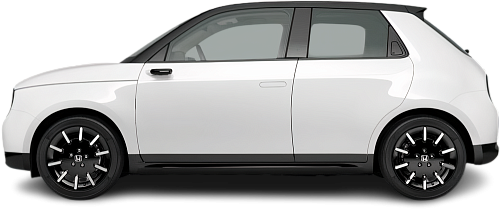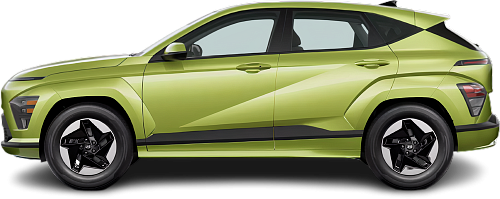Honda e Base vs Hyundai Kona Electric Standard Range
Struggling to Decide? Let AI Help!
Your AI Summary Is Ready!
General Info
The Hyundai Kona Electric Standard Range (2023-…) is currently produced, it has a starting price of $32675. The Honda e (2020-2022) has been discontinued, it was never offered for sale in the United States.
The Honda e (2020-2022) is a Hatchback, whereas the Hyundai Kona Electric Standard Range (2023-…) is a SUV.
| Property | Honda e Base | Hyundai Kona Electric Standard Range |
|---|---|---|
| Years of Production | 2020-2022 | 2023-… |
| Current Status | Discontinued | Produced |
| Country of Manufacture | Japan | Czech Republic, India, South Korea |
| Body Style | Hatchback | SUV |
| Market Availability | EU | EU, USA |
| Price USA (New) | - Price USA (New) | $32675 |
| Price USA (Used) | - Price USA (Used) | $20798 |
| GCC Score | 4.6 | 5.7 |
Range and Efficiency
While the Hyundai Kona Electric Standard Range (2023-…) offers a longer real-world range and a bigger battery, it is less energy-efficient than the Honda e (2020-2022).
| Property | Honda e Base | Hyundai Kona Electric Standard Range |
|---|---|---|
| Range (EPA) | - Range (EPA) | 200 mi |
| Range (WLTP) | 138 mi | 234 mi |
| Range (GCC) | 117 mi | 194 mi |
| Battery Capacity (Nominal) | 35.5 kWh | 51 kWh |
| Battery Capacity (Usable) | 28.5 kWh | 48.4 kWh |
| Efficiency per 100 mi | 24.4 kWh/100 mi | 24.9 kWh/100 mi |
| Efficiency per kWh | 4.11 mi/kWh | 4.01 mi/kWh |
| Range and Efficiency Score | 5.7 | 6.6 |
Charging
Both vehicles utilize a standard 400-volt architecture.
The Hyundai Kona Electric Standard Range (2023-…) offers faster charging speeds at DC stations, reaching up to 75 kW, while the Honda e (2020-2022) maxes out at 46 kW.
The Hyundai Kona Electric Standard Range (2023-…) features a more powerful on-board charger, supporting a maximum AC charging power of 11 kW, whereas the Honda e (2020-2022) is limited to 6.6 kW.
| Property | Honda e Base | Hyundai Kona Electric Standard Range |
|---|---|---|
| Max Charging Power (AC) | 6.6 kW | 11 kW |
| Max Charging Power (DC) | 46 kW | 75 kW |
| Architecture | 400 V | 400 V |
| Charge Port | CCS Type 2 | CCS Type 1 |
| Charging Score | 3.5 | 5.4 |
Performance
The Honda e (2020-2022) is rear-wheel drive, while the Hyundai Kona Electric Standard Range (2023-…) offers a front-wheel drive system.
Although the Honda e (2020-2022) has more power, the Hyundai Kona Electric Standard Range (2023-…) achieves a faster 0-60 mph time.
| Property | Honda e Base | Hyundai Kona Electric Standard Range |
|---|---|---|
| Drive Type | RWD | FWD |
| Motor Type | PMSM | PMSM |
| Motor Power (kW) | 100 kW | 99 kW |
| Motor Power (hp) | 134 hp | 133 hp |
| Motor Torque | 232 lb-ft | 188 lb-ft |
| 0-60 mph | 8.7 s | 8.5 s |
| Top Speed | 90 mph | 99 mph |
| Performance Score | 2.8 | 2.9 |
Dimensions
The Hyundai Kona Electric Standard Range (2023-…) is longer, wider, and taller.
The Hyundai Kona Electric Standard Range (2023-…) boasts a more extended wheelbase.
| Property | Honda e Base | Hyundai Kona Electric Standard Range |
|---|---|---|
| Length | 153.3 in | 171.5 in |
| Width (with Mirrors) | - Width (with Mirrors) | 82.6 in |
| Width (w/o Mirrors) | 69 in | 71.9 in |
| Height | 59.5 in | 62 in |
| Wheelbase | 99.9 in | 104.7 in |
Cargo and Towing
The Hyundai Kona Electric Standard Range (2023-…) provides more cargo capacity, featuring both a larger trunk and more space with the rear seats folded.
A frunk (front trunk) is available in the Hyundai Kona Electric Standard Range (2023-…), but the Honda e (2020-2022) doesn’t have one.
The Hyundai Kona Electric Standard Range (2023-…) has a towing capacity of up to 661 lb, whereas the Honda e (2020-2022) is not officially rated for towing in the US.
| Property | Honda e Base | Hyundai Kona Electric Standard Range |
|---|---|---|
| Number of Seats | 4 | 5 |
| Curb Weight | 3501 lb | 3571 lb |
| Cargo Volume (Trunk) | 6 ft3 | 25.5 ft3 |
| Cargo Volume (Max) | 30.4 ft3 | 63.7 ft3 |
| Cargo Volume (Frunk) | - Cargo Volume (Frunk) | 1 ft3 |
| Towing Capacity | - Towing Capacity | 661 lb |
| Cargo and Towing Score | 3.8 | 6.2 |




